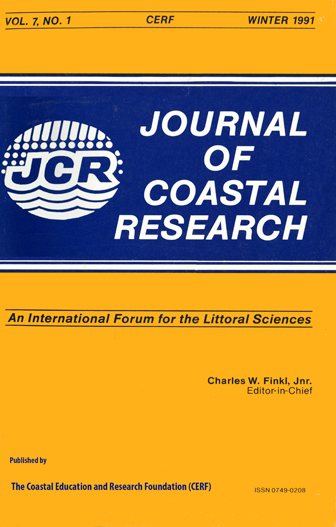Equilibrium Beach Profiles: Characteristics and Applications
Keywords:
Beach erosion, nourishment, sea level rise, seawallsAbstract
An understanding of equilibrium beach profiles can be useful in a number of types of coastal engineering projects. Empirical correlations between a scale parameter and the sediment size or fall velocity allow computation of equilibrium beach profiles. The most often used form is h(y) = Ay2/3 in which h is the water depth at a distance y from the shoreline and A is the sediment-dependent scale parameter. Expressions for shoreline position change are presented for arbitrary water levels and wave heights. Application of equilibrium beach profile concepts to profile changes seaward of a seawall include effects of sea level change and arbitrary wave heights. For fixed wave heights and increasing water level, the additional depth adjacent to the seawall first increases, then decreases to zero for a wave height just breaking at the seawall. Shoreline recession and implications due to increased sea level and wave heights are examined. It is shown, for the equilibrium profile form examined, that the effect of wave set-up on recession is small compared to expected storm tides during storms. Profile evolution from a uniform slope is shown to result in five different profile types, depending on initial slope, sediment characteristics, berm height and depth of active sediment redistribution. The reduction in required sand volumes through perching of a nourished beach by an offshore sill is examined for arbitrary sediment and sill combinations. When beaches are nourished with a sediment of arbitrary but uniform size, it is found that three types of profiles can result: (1) submerged profiles in which the placed sediment is of smaller diameter than the native and all of the sediment equilibrates underwater with no widening of the dry beach, (2) non-intersecting profiles in which the sea- ward portion of the placed material lies above the original profile at that location, and (3) intersecting profiles with the placed sand coarser than the native and resulting in the placed profile intersecting with the original profile. Equations and graphs are presented portraying the additional dry beach width for differing volumes of sand of varying sizes relative to the native. The offshore volumetric redistribution of material due to sea level rise as a function of water depth is of interest in interpreting the cause of shoreline recession. If only offshore transport occurs and the surveys extend over the active profile, the net volumetric change is zero. It is shown that the maximum volume change due to cross-shore sediment redistribution is only a fraction of the product of the active vertical profile dimension and shoreline recession. The paper presents several other applications of equilibrium beach profiles to problems of coastal engineering interest.


